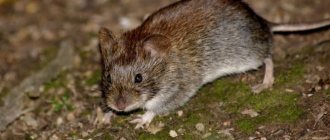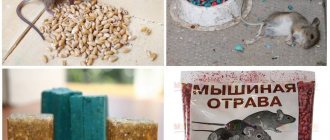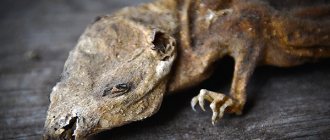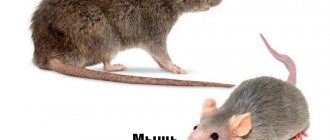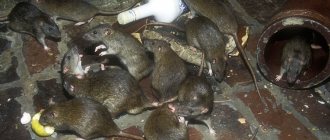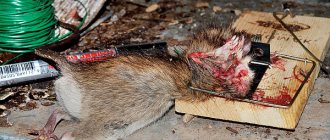Rat size and weight
2 messages
It is not clear why this happens, but for some reason people always ask “how many centimeters is a rat”, “how long do rats grow”, “what size are rats”, etc. Rats are not measured in centimeters, at all.
Mainly because of the rat’s restlessness and the characteristics of the rat’s body: it can be as stretched or collected as desired, so the results will differ by tens of centimeters - 0 cm in the case of “she turned around and even dragged the ruler”, 10 cm if the rat “suddenly decided shrink,” and up to 40 cm, if the animal suddenly stretches out like chewing gum. Rats are not measured, rats are weighed! For this purpose, any self-respecting rat breeder has a kitchen scale at home. How much do rats weigh?
The next question is usually “how much should a rat weigh?” Well, first things first: a rat doesn't owe anyone anything. It can weigh as much as you like and there is nothing you can do about it. The weight of an adult animal, as well as life expectancy, depends on many factors; the origin of the rat and its heredity also play a major role here. A secondary role is again given to the maintenance, feeding and health of the rat.
And yet, certain average weight indicators for rats exist (it’s a pity that rats don’t know about them). The average female (“spherical rat in a vacuum”) weighs 280-350g, the average male weighs 500-600g. If the weight is lower, then the animal is either thin or small; if the weight is higher, then the rat is either large or fat. Please do not rush to fatten or put on a diet your rat who does not meet the average weight limit! The build of a rat is judged not based on weight, but by touching and examining it and either finding solid bones (thin), muscles (good), fat (fat). If you are not sure whether your rat is fat, normal or emaciated, then contact specialists on the forum, they will tell you.
Keeping a pet rat
Keeping a pet rat
If you dream of having a pet, but cannot afford to have a kitten or puppy for some reason, then opt for a decorative rat. Rats are very clean animals and are very easy to train. There are several varieties of decorative rats: standard, tailless, curly, satin, sphinx and dumbo.
So, you can definitely find an animal to your liking. Of course, some people are very dismissive of rats, but if you still decide to purchase one, you will not regret it. After all, they have such charming beady eyes and they quickly get used to their owner by smell, immediately recognizing him in the future.
But that's not all, you can teach her various cute tricks and respond to your voice
Decorative rats can grow up to 20 cm in length and this is only the body, and there is also a tail, which can also reach 20 cm. Male rats weigh about 500 g, and females weigh the least, only 300 g.
The color of decorative rats is mostly monochromatic, but some varieties of rats can have two-colored fur. The color of the rat's eyes also depends on the color of its fur; a white rat may have red eyes. The lifespan of decorative rats reaches 3-4 years.
What determines the size and weight of a rat?
The size and weight of the animal is influenced by many factors:
- health;
- genetics;
- type of rat;
- conditions of detention.
Based on your desires, keep in mind that no matter how good the living conditions are, the genetics and pedigree of the rodent will negate all your efforts.
When buying a baby rat at a pet store, be prepared for the fact that it may lag behind in development. Sellers buy very small cubs that were separated from their mother early. This affects their health and life in general. It is better to take rats from trusted breeders.
Size and weight of wild rats
Pasyuk is a large wild and predatory rat. It reaches twenty-five centimeters in length and weighs about 230-250 g. They live everywhere and live in burrows. The animal is quite aggressive and often attacks cats, dogs and even people. Such a rodent can easily fight back against its offenders.
The bamboo rat is a large representative of the family. The body length reaches 48-50 cm, the tail is relatively short 10-15 cm, weight - 2.5 kg. They live in Indochina, Burma, Thailand, and on the island of Sumatra. She spends almost her entire life underground, in burrows. Moves slowly. In China, the rodent is eaten. The main food is bamboo.
The wild Turkestan rat is another large rat. Unlike the Pasyuk, it is not aggressive and often lives side by side with people in rural and urban buildings. Lives in Uzbekistan, Kyrgyzstan, Kazakhstan, Tajikistan. Weight reaches 800-900 g.
The gray rat is the largest rat in Russia. The length reaches 17-25 centimeters, the tail is 20 cm. Weight is about 150-400 g. Representatives of the Indonesian rat were spotted in the Moscow metro; even dogs are afraid of them. Over the past decade, according to Rospotrebnadzor, the number of these rodents has exceeded the population of Moscow several dozen times.
Distinctive features of a young rat
To approximate the age of a rat, you need to weigh it. At the same time, the weight of the male and female is different. When purchasing a pet, you can approximately determine its age, taking into account fixed weight parameters. For the female they are:
- At 2 months 150-200 g.
- At 3 months 210-250 g.
- At 4 months 260-290 g.
- At 5 months 300-340 g.
When choosing a male, the basic weight indicators change upward:
- At 2 months 160-220 g.
- At 3 months 230-310 g.
- At 4 months 320-410 g.
- At 5 months 420-490 g.
What determines the size of a rat and its weight?
The fact whether an animal will become large or small when it grows up depends on many reasons:
Therefore, when purchasing a pet, you must see its parents. Small animals never give birth to giants. Therefore, no matter how diligent the owners are in keeping a rodent, genetics will negate all their efforts.
Important! Animals purchased in pet stores usually lag behind in growth compared to their counterparts raised in nurseries, since sellers rarely purchase rat pups older than 3 weeks. Babies need 25-28 days to stay with their mother. Early weaning from it affects the health of the individual.
It is difficult to measure the length of a pet, since the animal is extremely flexible.
The animal’s body is designed in such a way that it can stretch up to 40 cm, and is flattened or compressed into a lump 10 cm long.
Although some experienced breeders and zoologists still manage to take measurements of animals that are in a normal calm state.
Age of animals by human standards
The scheme for projecting the age of an animal onto human years is quite approximate, but it gives the owner at least an approximate understanding of how long his pet has lived. Already from 6 weeks, rodents begin puberty, which passes quite quickly. This stage can be equated to 12–13 years when converted to human age. At the moment, it is undesirable to mate a male and a female, since the animal’s body is not yet fully formed, and the offspring may be born too weak and even defective.
Important! Already at 15 months, animals enter menopause, when in most cases they can no longer give birth to offspring. This corresponds to approximately 48 human years.
Already at the age of 5 months, the rat is considered sexually mature. This stage is equivalent to the age of 18 in humans. From this moment on, the ratio of the years of an animal and a person can be calculated using the formula: Age of the rat = number of complete months lived × 2.5.
The largest and smallest species of rats on the planet
There are real giants among these rodents in the world. In China, bamboo rats live, which reach 4 kg in weight and grow up to half a meter.
And in Africa you can find a reed rat, the size of an adult individual of which is 61 cm. Such a miracle weighs almost 9 kg. In captivity, it can only be kept under conditions artificially created for it.
The smallest species live in New Guinea, the Pacific Islands and Central Asia. They are called Pacific. The body of the animal ranges from 11 to 15 cm, and the weight of an adult rat is no more than 80g.
How to determine the age of a decorative rat
If you definitely don’t know how many months your pet is, you can determine this by external signs such as size, weight and tail length. These calculations are approximate and may differ depending on the sex of the rodent.
| Age, months | Size | Weight |
| 2 | up to 10 cm | up to 220 g |
| 3 | up to 15 cm | up to 315 g |
| 4 | up to 20 cm | up to 415 g |
| 5 | up to 25 cm | up to 495 g |
Did you know? Approximate calculations by experts have shown that today there are about 14 billion rats on the planet.
When a rodent has reached six months of age, you can determine how many months it has already lived by the length of its tail, which begins to actively grow during this period. If a rat's tail is shorter than its body, the animal has not yet reached one year of age. In mature individuals it can grow up to 30 cm.
Wild rats in Russia
These animals are found everywhere in our country: in nature and near human habitations. Among the wild undomesticated species we live:
In their natural habitat, pasyuki grow up to 25 cm without taking into account the tail and can weigh 400 g. Occasionally, representatives weighing half a kilo are found.
The black variety is slightly inferior to the pasyuki. They are found from 18 to 22 cm with a mass of up to 300 g.
Turkestan red rats are the smallest among this group: from 17 to 21 cm in length and weighing 280 g.
There is a myth that among the wild inhabitants of sewers and chemical plants, giant mutants up to a kilogram in weight and the height of a large cat appear from time to time. However, no such facts were documented.
The largest rats in Russia
Animals are found everywhere in our country: in nature, near human habitation.
Among the wild species there are:
- large gray;
- black;
- Turkestan, red.
In Russia, the largest rat is the pasyuk, which grows up to 25 cm, excluding the length of the tail. At the same time, the weight reaches 400 g, sometimes there are individuals up to 500 g. Black ones are slightly inferior to gray ones, sizes reach 18 - 22 cm, with a weight of 300 g. The smallest are Turkestan red ones. Body length reaches 17 – 21 cm, weight – 280 g.
There are myths that huge mutants, reaching a weight of 1 kg, live in chemical plants, as well as among the inhabitants of sewers. Their size is compared to large cats. But this information has not received official confirmation.
Moscow metro drivers love to scare others with horror stories about huge rodents inhabiting underground tunnels. These animals are supposedly the size of a large dog and have red or green eyes that glow with an otherworldly light. Monsters are incredibly aggressive, immune to baits and poisons.
Chilling stories have no real confirmation. The largest in Russia are pasyuki with a body length of 40 cm, and without a tail - 25 cm. That is why all the stories about giant rats are nothing more than fantasy.
Pasyuki feed on food leftovers in landfills and can consume plant and animal foods. The invasion of rodents frightens many people with the impending damage to things and products, aggressive behavior, and the many dangerous pathologies that these animals suffer.
The pasyuk's closest relative is the black rat, which prefers to live in attics and warm, dry basements. The body length of an adult animal is 22 cm, weight is no more than 300 g. Both types of animals cannot be compared in size with a cat or a dog, so all stories about the invasion of giant rats should only cause irony.
